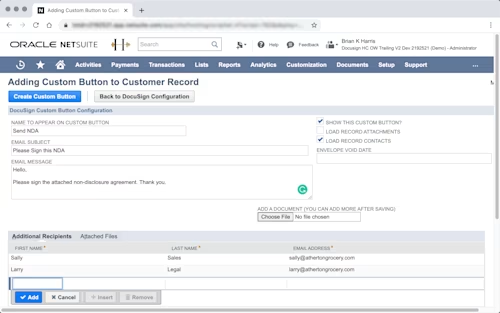
Melhore a eficiência dos negócios com a nova integração do Docusign para NetSuite
A nova versão da integração do Docusign para Netsuite duas novas funcionalidades: botão costumizável para os formulários e mesclagem de campo.

Os contratos são a base de muitos processos de negócios. Mas antes que um contrato como um NDA, PO, MSA ou formulário de pedido possa ser assinado, ele deve ser gerado e aprovado, geralmente com várias rodadas de correção e revisão jurídica. Embora a maioria dos contratos possa ser preparada com base em modelos ou copiando e editando um documento existente, eles ainda exigem que os representantes de vendas — ou pior, os clientes — preencham manualmente os campos com informações e enviem os documentos. Erros de digitação e outros erros só causam retrabalho e atrasos, isso supondo que o representante use o modelo certo inicialmente. Uma pesquisa mostrou que 63% dos profissionais de vendas afirmam sofrer com o retrabalho por conta de erros manuais em contratos.
Hoje, os representantes de vendas, gerentes de fornecimento e profissionais de operações devem poder clicar em um botão e gerar um contrato refinado, mas facilmente editável, diretamente de um registro em seu sistema CRM ou ERP — com base no modelo correto com a maioria, se não todos, os campos já preenchidos — e encaminhá-los automaticamente para os aprovadores ou signatários certos na ordem certa.
E uma vez que o contrato é assinado, os processos downstream precisam ser executados, como provisionar a conta do cliente ou iniciar o faturamento. Conectar a conclusão do contrato a outros sistemas que precisam agir sobre ele economiza um tempo valioso para sua equipe de vendas. Um documento de contrato assinado pode ser armazenado automaticamente com o registro adequado em seu sistema de registros. Um sistema de cobrança pode ser notificado automaticamente ou você pode até aceitar pagamentos como parte do processo de conclusão da assinatura. Mais importante do que isso, os funcionários não precisam gastar seu tempo executando ou monitorando essas tarefas; eles podem voltar aos negócios.
O conector do Docusign para NetSuite é a maneira mais fácil para os usuários do NetSuite fecharem mais negócios coletando, rastreando e armazenando assinaturas de clientes, tudo dentro do NetSuite. A nova versão da integração Docusign para Netsuite (v2020.09) inclui dois novos recursos: Formulários de botão personalizados e campos de mesclagem.
Os botões personalizados permitem que os administradores do NetSuite criem fluxos de trabalho personalizados que seus usuários podem acionar com o clique de um botão. Por exemplo, uma organização pode criar um botão para enviar um NDA para um novo cliente em potencial (veja a imagem abaixo) com uma mensagem de e-mail pré-preenchida e um documento para assinar. Em seguida, os representantes de vendas podem acionar esse fluxo de trabalho com rapidez e facilidade no registro do NetSuite.

Antes desta nova versão, os botões personalizados exigiam que um administrador escrevesse JavaScript usando a documentação da API do Docusign, geralmente um processo demorado e propenso a erros. Os novos formulários de botões personalizados (veja a imagem abaixo) fornecem uma interface de usuário sem código para botões personalizados.
Criar um botão personalizado

Os formulários de botão personalizados simplificam muito a criação e a manutenção de fluxos de trabalho personalizados do Docusign no NetSuite, reduzindo o tempo de retorno do investimento e aumentando a flexibilidade, agilidade e eficácia da implementação do NetSuite CRM e ERP.
O processo de envio de contrato, PO, fatura ou qualquer outro tipo de documento para assinatura eletrônica nunca foi tão fácil: basta clicar no botão "Enviar com Docusign" em uma Oportunidade, Orçamento, Cliente ou objeto personalizado para enviar documentos para assinatura, preenchidos com as informações apropriadas do destinatário. Use o botão "Assinar com Docusign" para assinar ou incluir informações adicionais em um documento anexado a um registro.
Uma novidade para os formulários de botão personalizados são os campos de mesclagem. Os campos de mesclagem importam automaticamente os dados do NetSuite para um modelo do Docusign para que os destinatários não precisem inserir dados manualmente antes de assinar. Os campos do modelo são pré-preenchidos, eliminando a inserção de dados demorada e propensa a erros para o remetente e simplificando a experiência de assinatura. Os formulários de botão personalizados funcionam com tipos de registro de CRM e de ERP, para que os usuários possam criar fluxos de trabalho personalizados para atender às suas movimentações de vendas, interações com clientes, faturamento, pedidos de compras e muito mais.
Tipos de registro do NetSuite disponíveis para formulários de botão personalizados:
Cliente
Orçamento
Fatura
Oportunidade
Ordem de compra
Ordens de vendas
As opções disponíveis para formulários de botão personalizados incluem:
Assunto de e-mail personalizado
Mensagem de e-mail personalizada
Carregar anexos de registro automaticamente
Carregar contatos de registro automaticamente
Data de anulação do envelope
Anexar documentos adicionais
Enviar para destinatários adicionais
Mesclar campos do NetSuite no modelo do Docusign
Entre em contato com nossos especialistas para saber mais ou confira a documentação de integração para obter mais informações.
Publicações relacionadas
 Soluções para equipesAtualizado em 10 de mar. de 2025
Soluções para equipesAtualizado em 10 de mar. de 2025 Soluções para equipesAtualizado em 5 de mar. de 2025
Soluções para equipesAtualizado em 5 de mar. de 2025Como a ordem de serviço digital pode transformar sua empresa?
 Soluções para equipesAtualizado em 25 de fev. de 2025
Soluções para equipesAtualizado em 25 de fev. de 2025Upsell: tudo o que você precisa saber

O que é no-code? Entenda o conceito, benefícios e desafios

Como a ordem de serviço digital pode transformar sua empresa?

Upsell: tudo o que você precisa saber
Confira as novidades do Docusign IAM ou comece a usar o eSignature grátis

